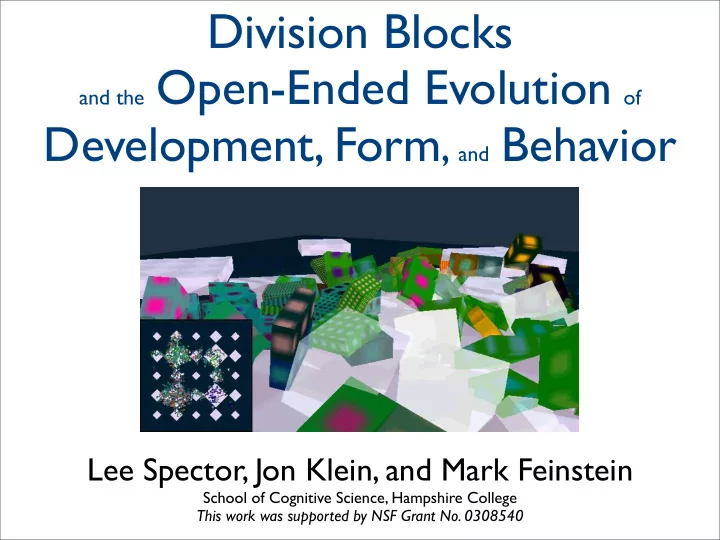

Division Blocks and the Open-Ended Evolution of Development, Form , and Behavior Lee Spector, Jon Klein, and Mark Feinstein School of Cognitive Science, Hampshire College This work was supported by NSF Grant No. 0308540
?
Goal • Explore, in silico, key interactions among development, form, physics, behavior (including reproductive behavior), and ecology that underpin biological evolution. • How do these factors interact, under natural selection, to produce adaptive complexity?
Open-Ended Evolution of Development, Form , and Behavior • Wide repertoire of possible developmental trajectories, forms, behaviors, and ecological interactions. • No pre-specified goals, just ecological interactions (possibly including aggregation and reproduction) within a resource- preserving 3D physical simulation. • Reproductive and aggregative behaviors also open-ended and may evolve.
Precursors • Tierra • Avida • Echo • Pushpop • Sims’s Creatures • Framsticks • Artificial Ontogeny • SwarmEvolve 2 • Robotic/structural evolution • Plant growth evolution • ...
Unfortunately Necessary • Outrageous simplifications. • Combinations of features normally observed at radically different scales.
SwarmEvolve 2
Sensors zero, plus, minus, energy, waste, exposure, pulse, rotx, roty, rotz, localtag, localenergy, localwaste, connectedtag, connectedenergy, connectedwaste, stemtag, stemenergy, stemwaste
Effectors sizex, sizey, sizez, jointx, jointy, jointz, stemx, stemy, stemz, tag, donationsize, donationtolerance, stemdonationsize, stemdonationtolerance, collectionsize, collectiontolerance, stemcollectionsize, stemcollectiontolerance, copyfidelity, mutationlimit, matecontribution, matetag, adhesion, pulserate, sigmoidcompression
Neural Network • Arbitrary recurrent architecture, genetically controlled. • Division (via growth) and genetics (mutation and crossover) controlled by network outputs. • Sigmoid activation function; steepness controlled by an effector:
Skin Patterns/colors show state. For results in paper: • Dot density = energy • Frame red = waste • Frame green = energy donation tolerance • Frame blue = energy donation size • Dot red = sun exposure • Dot green = waste collection tolerance • Dot blue = waste collection size
Waste
Reproductive Competence
Variations
Figure 4: Averaged data from 40 runs of the Division Blocks system, collected after 1000 time steps of reproductive competence. Er- ror bars indicate ± 1 standard deviation. A: average tag values; B: average donationsize (left) and (right); C: average donationtolerance (left) and stemdonationsize stemdonationtolerance (right); D: average matecontribution ; E: average adhesion .
Prospects • Cluster-based parallelism in progress. • Long term evolutionary patterns. • Unbounded evolutionary activity? • Track new measures of adaptive complexity. • Physical division blocks?
Recommend
More recommend